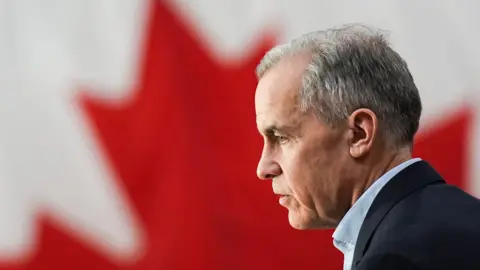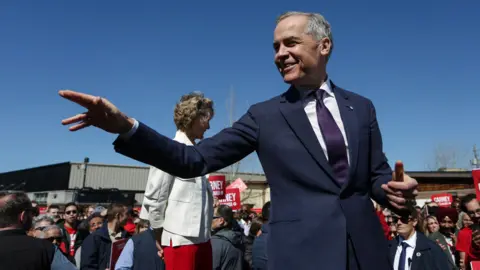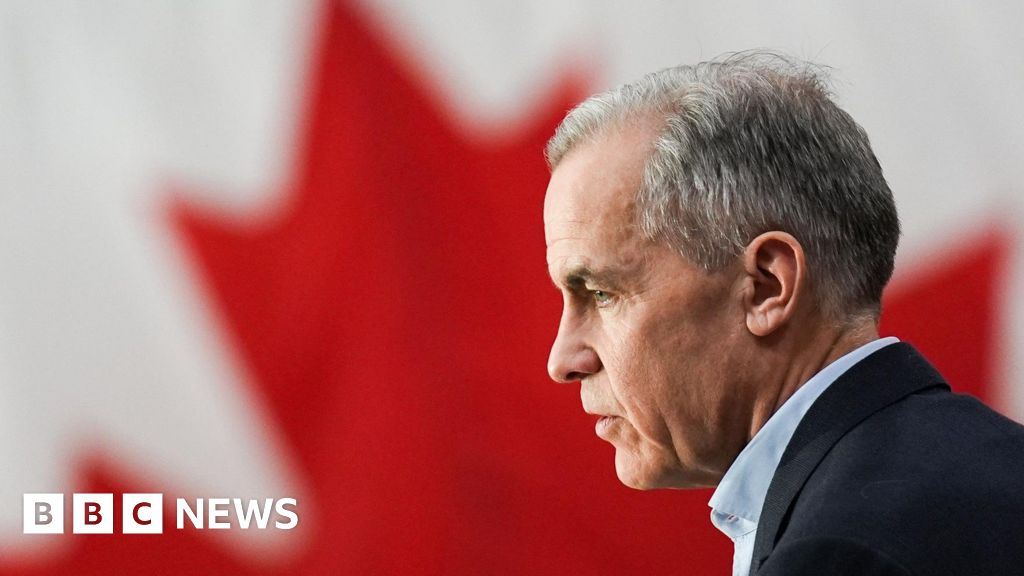 Getty Images
Getty ImagesOn Mark Carney’s final day of a gruelling race to be elected PM of vast and sparsely populated Canada I was with him.
It was his last push, not just to win, but also to get the majority he said he needed to stand up to the chaotic territorial and trade ambitions of his “neighbour to the south”.
For someone who had got to see Carney as a cerebral technocrat, a crisis-managing central bank governor a decade ago, the transformation into public orator was quite something.
I recall endless interviews trying to get the then governor to say something newsworthy, or something that would make a good headline.
While this was a very different Mark Carney, the lineage in crisis economics was also part of his sell.
Carney told his audience in Edmonton, Alberta, sporting the local Oilers hockey shirt: “President Trump has ruptured the global economy… America’s leadership of the global economy is over. It’s still in play, but it is a tragedy, and our new reality… in this trade war, just like in hockey, we will win”.
His supporters shouted “Elbows Up” and put them up, a reference to a stand up and fight back posture in the occasionally rough game of ice hockey.
“What we are seeing around the country is Canadians acting on behalf of other Canadians, standing up for each other, buying from each other, travelling here…”
At his very final stop in the far West, in the isolation of Victoria, Vancouver Island, with only half an hour of campaigning allowed, Carney went “unplugged” among supporters.
“As the assembled media will tell you, I campaigned in prose,” Carney joked. “So I’m going to govern in econometrics,” he said of the nerdy mathematical strain of economics.
In normal circumstances, some of this might be interesting to the wider world. In current circumstances, the origins of his election win, his approach to policy making, and the nature of his mandate, could assume critical importance.
When I caught up with him for the BBC exclusive interview, just as the polls were closing on Monday, he appeared confident but was taking nothing for granted.
Fighting threats to sovereignty
Mr Carney’s central argument remained consistent. He said he was the leader to take on Donald Trump’s “betrayal” and threats to Canada’s economy and sovereignty.
It was exemplified by his final large rally on the US-Canada border, with the Ambassador Bridge and a skyline of iconic Detroit motoring firms behind him.
This bridge is the main artery of Canadian-US trade. A lot of effort went into this backdrop of the two-way trade of the most integrated economies in the world, now tariffed at unimaginable levels. An unsubtle message from the Liberal Party leader, about a changed continent.
The election result was staggering.
Entering 2025, the Liberal Party was as low as 16%, versus 45% for the opposition Conservatives, in opinion polls.
Pierre Poilievre’s Conservatives were not just heading for victory, but for a total landslide.
But then following President Trump’s imposition of national security tariffs on Canada, using the pretext of an alleged role in fentanyl traffic, and then his undiplomatic suggestion that Canada should join the USA, the polls tightened.
Then after Mark Carney was elected Liberal leader, just eight weeks ago, the Liberals achieved a consistent poll lead, which they rode to victory last week.
The election became a presidential-style verdict on who could cope with Trump.
Poilievre was fundamentally weakened by previous overtures to the US president and his style of government.
Carney incorporated voters on the left who were scared of a Conservative government amplified by Trump.
And incredibly, in Quebec, the Liberals won back support from separatists, who were more concerned about Canada’s independence from the US, than their own constitutional status within Canada. There is nothing more unifying than a credible external threat.
Carney’s strategy
 Getty Images
Getty ImagesCarney gave some clues to his strategy during his interview with me. He talked of a “win win” partnership with the US, and reminded the president that Canada was the “biggest client” of 40 of the 50 US states, and a key energy and fertiliser supplier.
He also told me he “potentially could supply them with critical minerals”. This struck me as a negotiation tactic very targeted at what Trump has become fixated on elsewhere.
Canada has ample resources of critical minerals, and would be a much more dependable supplier across the West than many other nations. Carney is implicitly suggesting, however, that his country has deep strategic choices to make here, on for example, developing them with Europe rather than the US.
In any event, the PM will use the impetus of external threat to try to transform the Canadian economy. Even in the granting of an interview to BBC News, it was clear that he sees a critical need to diversify trade and strategic alliances. Defence partnerships are now on the cards.
He seemed to acknowledge that a stalled Canada-UK trade deal could be expedited.
On Friday he pulled off the historic announcement that King Charles would reopen the Canadian parliament in person at the end of the month. This has not happened since 1977. It is entirely in keeping with Canada’s constitution, but it is also a stunning assertion of enduring independence from the White House.
All roads now lead to the G7 Summit hosted by Carney in the middle of June in Alberta, bringing together the world’s seven largest economies, which dominate global trade and the international financial system.
Assuming that Trump comes, it will occur within days of the expiry of the pause in massive so-called “reciprocal tariffs” on most of the world.
It is often forgotten that if Canada and Mexico free themselves from the fentanyl tariffs, they will then, according to White House advisers, find themselves subject to this system, with a minimum of 10% tariffs.
All of this occurs within days of some growing frustration from America’s traditional allies with the entire “trade deal” process.
Japan is increasingly frustrated, with its finance minister now openly pointing to Japan’s unbeaten holding of US government debt as a “card” in negotiations.
The EU has not got very far. Even the UK has hinted that a deal with Europe may be a more effective way of boosting the economy.
It comes as tariffs are starting to have a visible and tangible negative impact on US businesses and consumers.
There is no great incentive to offer much up, while the US itself starts to feel the inevitable inflationary consequences of its actions.
The flotilla of empty Chinese cargo ships and empty docks on the US West Coast will soon be seen in the economic data of an already shrinking US economy.
As a veteran of economic crises arising from the uncertain experiments of governments, Carney might be uniquely placed on how these situations pan out. Many in the markets have been thoroughly unimpressed with the White House advisers sent out to reassure investors in recent weeks.
But Carney too has his own challenges. He just missed out on a majority in parliament, but has chosen to try to project this as a virtue.
He will reach across the aisle for a “Team Canada” approach to talks with the US.
The Premier of the oil-rich Alberta state, who is a regular visitor to Mar-a-Lago, immediately announced moves to make separation referendums easier.
This is a very complicated, domestic, continental and global environment economically and politically. Few would predict exactly where it goes. Carney may have a very large part in it, and not just for his own country.

